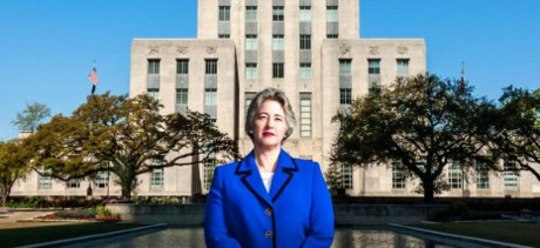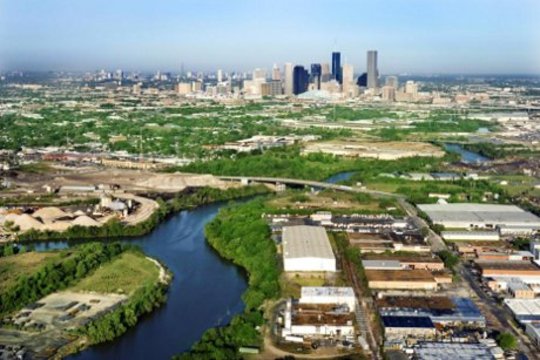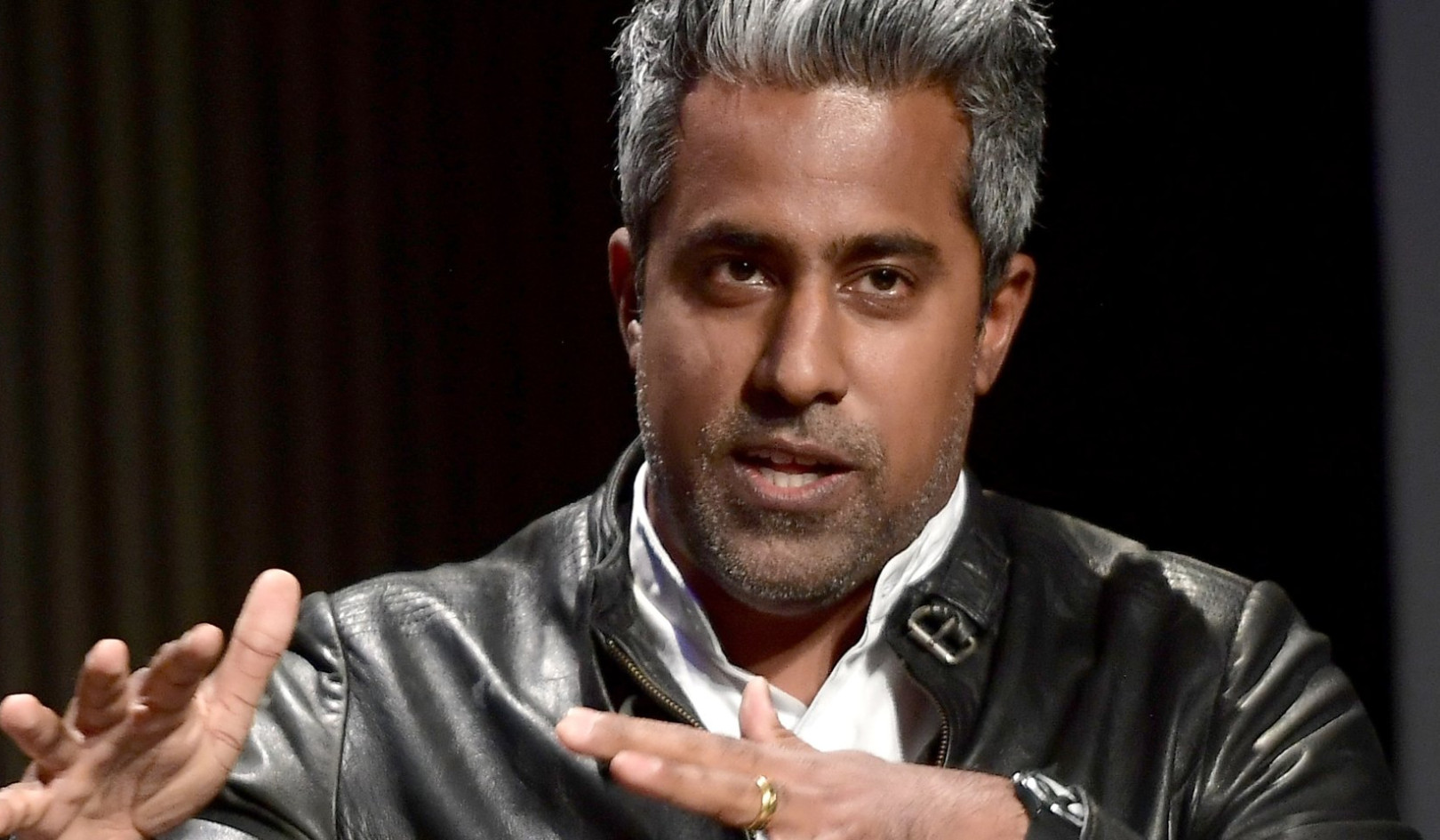 Mayor Annise Parker stands her ground at City Hall. Photo: Jeff Wilson
Mayor Annise Parker stands her ground at City Hall. Photo: Jeff Wilson
The U.S. capital of the oil industry could teach other cities a thing or two about fighting climate change—in a politically inhospitable climate.
Last February, Houston Mayor Annise Parker addressed an international climate summit in Johannesburg, South Africa, that was attended by a number of her fellow mayors from some of the world’s biggest, most illustrious cities. The topic of the three-day event was how the combined energies of these cities might best be marshaled to combat global climate change, especially at a time when the larger international effort to do so seems paralyzed by politics.
Amid all the earnest, admirable talk, “I did the skunk-in-the-yard thing,” recalls Parker, who took office in 2010 and is now in her third term. “They were talking about greenhouse gas emissions this and that, and I said, ‘I don’t talk about greenhouse gas emissions.’ ” As she tells the story, the mayor—her neck bedecked in pearls and her accent bearing the trace of childhood summers spent in Biloxi, Mississippi—smiles. “I said, ‘I talk about how doing this, this, and this will save you money. That’s what my constituents want to hear.’ ”
And yet no one at that international summit would have ever questioned Parker’s, or Houston’s, place at the table. Between 2007 and 2014, Houston, the country’s fourth most populous metropolis, slashed greenhouse gas emissions across its vast municipal operations by 32 percent. For any of the other mayors in attendance that day, playing such an instrumental role in reducing their city’s carbon footprint would count as a remarkable accomplishment. But for the savvy, popular mayor presiding over the U.S. capital of the petrochemical industry—and in Texas, no less, where the denial of climate change is considered an article of faith for aspirants to statewide office—the accomplishment is nothing short of astounding.
The group convening that day in Johannesburg is known as the C40, a sort of sustainability secretariat for the world’s largest metropolises. Their meetings are the kinds of events where the mayor of Addis Ababa and his Copenhagen counterpart might exchange tips on the best place to buy wind turbines. Taken together, C40 cities represent 500 million people and 21 percent of the world’s gross domestic product. In 2013, Parker was elected to serve on the group’s steering committee—and the energy she has brought to the job is “something I’ve been marveling over,” says Seth Schultz, the organization’s research director.
At first, Houston might seem like an improbable candidate for leadership in a group like C40. Topographically featureless save for the curtain of pines to its north that mark the southern edge of the Piney Woods ecoregion, the city is as flat as a tabletop, sweltering in the summer months and prone to torrential rains that routinely swamp its bayous and low coastal prairies. Historically, nearby Galveston for many decades was able to boast the superior Gulf of Mexico port. But Houston’s boosterism was relentless, and in due time it became both the starting point and the terminus for most of the rail lines that cut through Texas during the late 19th century. It grew rich and wide on all the inland cotton that growers brought to its port, and on the clear-cut pine timber processed along Buffalo Bayou. When the Spindletop oil field began raining crude east of the city in 1901, the conditions were already ripe for Houston’s rapacious outward expansion.
“ 'Sustainability'? I assume the word has been poll-tested somewhere. But I don’t think people react to it the same way as they do to the word 'conservation'. Conservation is something [Houstonians] understand. ”
Overnight, a nascent petrochemical industry supplanted the sugar refiners and timber processors on the ship channel leading to the gulf, and shortly thereafter a metropolis dependent on the mass-produced automobile was born—unplanned and patternless, its land-use policies guided by the construction of highways in all directions. Houston became Houston through sheer ambition, reinforced by a reflexive hostility toward any environmental regulations that might constrain its growth—even if rejecting those regulations also meant, by the 1970s, breathing in some of the worst smog in the country. In its reliance on the automobile, in its dependence on air-conditioning as a check against the unbearable heat and humidity, and in its embrace of its identity as the fossil fuel industry’s company town, Houston became one of America’s most carbon-intensive cities. But at the same time, it grew and thrived.
And therein lies the tailored brilliance of Annise Parker’s sustainability pitch to the City That Crude Built. She arrived in office well informed. For nearly two decades before becoming mayor, Parker worked for the Mosbacher Energy Company, which was founded by a man who served as secretary of commerce under President George H.W. Bush and was run by a family of major GOP fundraisers. Parker’s job was to analyze computer models in order to gauge the risks and rewards associated with potential multimillion-dollar oil and gas projects. Along the way, she says, she picked up some shrewd insights into management that would one day serve her well in governance, among them “Know your people: their strengths, their weaknesses, and their biases.”
Parker’s immersion in the petrochemical industry, and her understanding of that industry’s existential relationship to her hometown, meant she also knew how slow Houstonians would likely be to tackle climate change for its own sake. So when the time came for the new mayor to speak up on the matter, she deftly borrowed from the local business patois of cost-cutting and efficiency. She energetically touted the need to curb the city’s greenhouse gas emissions but did so using the language of a CEO, citing “ancillary benefits” and “return on investment” rather than moral imperatives.
“Messaging is critical,” she says when discussing how she chose to frame her argument initially. In Houston, she adds, “we talk about saving money, reducing energy costs, and conserving water. Sustainability? I assume the word has been poll-tested somewhere. But I don’t think people react to it the same way as they do to the word conservation. Conservation is something [Houstonians] understand.”
As Parker explains her rhetorical strategy, she and I are sitting in her office, its wide windows framing a messy, sprawling American city in the throes of a late-afternoon rush hour. At that moment some 2.4 million automobile commuters are making slow progress along Houston’s massive network of highways, jockeying for position in a slightly faster traffic lane. Just out of view is an immense refinery complex, one of many in a state that produces more than a quarter of all refined petroleum in the nation. A little farther out, diesel-burning, ocean-going vessels are docking and departing in the Port of Houston—in terms of pure traffic, the busiest in the nation. All this represents Parker’s other constituency: the one built out of steel, asphalt, oil, and cargo. And although she’s obligated to think about it and worry about it and work with it, she can’t ever hope to exercise control over it. Much of it rests outside the city limits, and thus outside the boundaries of her jurisdiction. It makes her challenge all the more frustrating. But it’s also what makes her achievements all the more remarkable.
The morning after I met with Parker last August, I spent time with Adrian Shelley, the executive director of a local NGO called Air Alliance Houston. Together we took a discomfiting tour through the Houston area’s vast petrochemical complex, where some two million barrels of crude oil are refined every day. It was splayed along the banks of the Houston Ship Channel: a mud-colored ribbon that courses for 50 miles through a landscape of refineries before broadening into Galveston Bay and the Gulf of Mexico. We passed decades-old berms made of channel dredge material, stretching farther than the eye could see. We saw hummocks of petroleum coke—nearly pure carbon, the byproduct of refinery cracking units—that rose beneath the Beltway Bridge like a sea wall. We took in the three-mile expanse of the ExxonMobil refinery complex and stopped to marvel at a Superfund site, U.S. Oil Recovery, where poisonous chemicals had accumulated for years in dumpsters, bins, and tanks, eventually leaching into nearby Vince Bayou. We heard the deafening Niagara roar of LyondellBassell’s chemical plant, where we detected odors that defied easy description.
As we wound our way through this depopulated industrial cityscape, Shelley explained that he was raised on the other side of Houston: in the suburbs, away from the bright lights of refineries like Marathon Oil and Total Petrochemical. “I grew up where everyone worked in the industry—but in the offices, downtown,” he said. “Nobody ever went to the east or south side.” He spent his college summers interning for an oil company but went in the other direction after graduating and became an environmental attorney. He felt, he told me, as if he owed something to the people who had lived for so long in the shadow of the oil industry.
After several hours—and many miles spent crisscrossing the waterway, navigating between the refineries—Shelley began to complain of a headache. “It’s not uncommon to come away from a few hours on this side of town with a headache or a sore throat,” he told me. “Everyone reacts differently. There are things you hear from community members, stories that sound like myths. They might say, ‘I smelled something, and my nose started bleeding.’ Or ‘This company flares at night.’ These people know more than the air monitors will ever know.”
The Houston Ship Channel serves as an object lesson in the difficulties presented by municipal boundaries to any city’s good-faith effort to tackle pollutants and greenhouse gas emissions. The petrochemical complex is spread over a patchwork quilt of jurisdictions; only two of the refineries actually lie within the city limits of Houston. And regardless of whether a refinery falls technically within the city’s boundaries, Texas law affords municipalities precious little discretion when it comes to enforcing the state’s own Clean Air Act. Quite often, the only way for mayors to address egregious polluters and emitters is through the court system.
 One of the oil refineries that faces downtown Houston. Photo: Jupiterimages
One of the oil refineries that faces downtown Houston. Photo: Jupiterimages
Given this enforcement vacuum, Parker believes she has been as effective as she can be in working with the oil industry, even though she may lack the power to tell most companies what they can and can’t do. Among her strategies: being something of a friendly, if busybody-ish, next-door neighbor when it comes to dealing with the refineries she suspects to be in violation of laws regarding toxins and emissions. For example, instead of relying on state environmental regulators to continually monitor refinery emissions and enforce the rules (a reliance that, given the pro-business leanings of those same regulators, would likely yield unsatisfactory results), Parker’s administration has invested about $9 million in its own air-monitoring equipment, installing monitors at strategic points near municipal borders “so that we could create our own record of violation and then try to work directly with the plants.”
Even if Parker did have greater legal means at her disposal to get bad environmental actors to cease and desist, the anti-regulation business culture of Houston would make such action politically difficult. The better way to lead the city into its sustainable future, as both Parker and her predecessor, Bill White, realized early on in their administrations, is through example rather than coercion. Before Houston could boast the nation’s fourth-highest number of LEED-certified buildings and projects, for example, someone had to prove to businesses and developers that designing buildings for maximum energy efficiency wouldn’t add prohibitive costs to construction and maintenance.
Houston took the lead on LEED by retrofitting some six million square feet of municipal buildings with more efficient heating, ventilation, and air-conditioning systems; “cool” roofs that reflect heat; and indoor lights that switch off automatically when rooms are empty. Such improvements are expected to reduce energy consumption by at least 30 percent, allowing Houston to recoup its initial cash outlay in fewer than 10 years and saving the city millions of dollars annually from that point on.
In 2010, as part of the Clinton Climate Initiative, the City of Houston helped convince major grocers—including Costco, Sam’s Club, and Walmart—to stop sending their food waste to a local landfill and to send it instead to a composting facility equipped to capture the methane this waste gives off as it decomposes. (Though it dissipates more quickly than carbon dioxide, methane is 20 times more potent than CO2 at trapping radiation inside the earth’s atmosphere.) Persuading these grocers to divert their garbage has cost Houston nothing, but it will yield a massive environmental dividend.
That highly favorable cost-benefit ratio has inspired Parker’s most recent sustainability moonshot: a giant, and largely automated, single-stream waste facility that can separate recyclables from food waste, resulting in a much higher rate of recovery than voluntary recycling efforts by households and businesses could ever hope to achieve. The mayor sees this initiative, called One Bin for All, as fundamentally redefining Houston’s relationship with its refuse, turning its waste stream into a potential revenue stream and yielding along the way a massive climate benefit: For each ton of solid waste diverted, 3.72 metric tons of greenhouse gas will be kept from entering the atmosphere.
Consistent with Parker’s message that money is what talks in Houston, her constituents had to take notice when she announced that she had figured out a simple way to save taxpayers $3 million a year in energy costs: by replacing incandescent bulbs with LED bulbs in streetlights at 2,450 traffic intersections. Over the life of this bulb-replacement project—which will ultimately affect more than 165,000 streetlights—the city will realize an annual savings of some $28 million and reduce its greenhouse gas emissions by another 5 percent. And in a state famous for doing everything just a little bit bigger, Houston has hewed to that tradition and tweaked it for the era of climate change by becoming the single-largest municipal purchaser of renewable energy in the country. Half of the electricity used by the City of Houston—enough to power more than 55,000 homes annually—currently comes from renewable sources.
As was the case for so many large cities in the American South and Southwest, Houston watched for decades as tens of thousands of residents moved away from the city center and into the surrounding suburbs. Now Parker is encouraging Houstonians to live once again where they eat, work, and play. There are signs that Houston’s urban core is beginning to become denser, after decades during which the development of multiunit housing and townhouse-style units was either legally curtailed or economically discouraged within the city limits. Under one initiative, some real estate developers whose plans contribute to a denser cityscape can receive financial assistance in the form of tax abatements for their projects or reimbursement for infrastructure improvements. In addition, many young professionals in the creative and high-tech fields—the workers that cities are competing for—list accessible public transit as something highly desirable. Accordingly, Houston has a $192.5 million rapid-transit bus system it hopes to open by 2017. Some 30 miles’ worth of new lines for its light-rail network are also on the way, connecting downtown to the city’s East End and southeastern neighborhoods.
In other words, Houston is sincere about trying to remake its inefficient, 20th-century sprawl into a 21st-century vertical metropolis—a place that transcends its deep historical roots in fossil fuels by acknowledging their instrumental role in a changing climate and by reducing its consumption of them accordingly. But there is another acknowledgement at work here, and it signals the city’s understanding of a hard reality. While Houston plans for the future to which it aspires, it must simultaneously prepare for the future it is unable to prevent.
That the world’s cities would become the new front line in the effort to stem the worst effects of climate change makes eminent good sense when one considers the way this worldwide problem tends to manifest itself at the local level. For the first time in the history of humankind, some 50 percent of the earth’s population now lives in sprawling urban centers like Houston; by 2050, that figure is projected to reach nearly 70 percent. As population centers and hubs of economic activity, big cities necessarily contribute the vast majority of global climate emissions. But according to C40 research director Schultz, cities also “know how to deal with problems in real time—which makes them living laboratories for how humanity is reacting to climate change.” Many of them, not coincidentally, are on coastlines, leaving them uniquely vulnerable to sea-level rise and the impacts of severe storms. These cities can’t wait for public opinion or political deal making to authorize their salvations. By the time the last campaign is won and the last deal is made, their shores may well have already disappeared.
Still, there are climate-related threats to the Houston metropolitan area that are beyond any one mayor’s, or any one municipality’s, power to avert. And there are sustainability plans that can’t be discussed without mentioning that the resultant savings will be measured not only in dollars but also in the harder currency of human lives.
 The 50-mile-long Houston Ship Channel conveys ships
The 50-mile-long Houston Ship Channel conveys ships
from Galveston Bay to Houston. Photo: Jupiterimages
One of the biggest topics here is water—and more specifically, rising water. A number of Parker’s projects have attempted to strike a balance between city beautification and disaster prevention, such as the Bayou Greenways initiative, an approximately $480 million public-private partnership that proposes to line the city’s bayous with 4,000 acres of new green space. This will act as a natural and highly effective form of flood control but will look to most Houstonians very much like a system of interconnected public parks. Still, such undertakings, worthy though they may be, elide the larger issue of what would become of Houston and its surrounding towns should a major hurricane make landfall in Galveston Bay, where the infrastructure-lined Houston Ship Channel terminates.
Two inescapable truths pertain to climate change’s potential impact on Galveston Bay. The first is that the rate of sea-level rise on the Texas Gulf Coast—based on geological records that go back millennia—is several times greater today than it was in prehistoric times. The second truth is that as our ocean temperatures continue to rise, the hurricanes that form and churn seasonally over the Gulf of Mexico will have far greater stores of violent energy to draw upon. Storms that would have previously been described as merely “bad” will more frequently be “devastating.” And the images a man named Jim Blackburn might previously have described as troubling will become downright disturbing.
Blackburn is an environmental attorney and a professor of environmental law at Rice University, and what he fears most is the wholesale destruction of the many miles of industrial infrastructure lining the Houston Ship Channel, from the petrochemical complex out to the bay. According to him, that’s exactly what could happen if an Ike-level hurricane were to make landfall at the point where bay and channel meet.
Ike, a massive tropical cyclone that would probably be better remembered today had it not struck during the height of the 2008 financial crisis, caused some $25 billion in damage in Texas, Louisiana, and Arkansas. On the Gulf Coast, the scope of its impact ranged from the eastern end of Galveston Island to the town of Grand Isle, just south of New Orleans. But according to a report Blackburn and his Rice colleagues published earlier this year, had the exact same storm made landfall just 30 miles to the west, we would have witnessed disaster on a very different scale. Blackburn says Ike could have generated between 18 and 20 feet of storm surge in the Houston Ship Channel itself, and up to 15 feet of storm surge in the built-up and heavily populated communities on the west side of Galveston Bay. In this scenario, thousands of people who chose not to evacuate could have died. In addition, the report’s authors concluded that “the environmental impact to Galveston Bay and economic devastation to the [larger] region and the U.S. would have been irreparable.”
“ If you have a major flood on the ship channel…it could easily be the worst environmental disaster in U.S. history. ”
It’s estimated that as many as 1,100 storage tanks on the channel—some of them massive, and most of them containing thousands of barrels of crude oil and/or hazardous chemicals—are, at this very moment, vulnerable to the type of storm-surge-related disaster spelled out by Blackburn’s report. Were these tanks to become unmoored and torn open by the force of an 18- to 20-foot surge (or by the heavy, fast-moving debris such a surge would likely carry with it), the resulting toxic tide would rush inland toward some of the most densely populated parts of the Houston metropolitan area. “If you have a major flood on the channel—tanks are spilling, lines are ruptured—that [spillage] isn’t going to leave the bay” and flow out to the gulf, Blackburn says. “It’s going to come back. And it could easily be the worst environmental disaster in U.S. history.”
According to estimates from Rice’s Severe Storm Prediction, Education, and Evacuation from Disasters (SSPEED) Center, which Blackburn leads, an event like the one described could cause, in addition to hundreds or even thousands of deaths, as much as $100 billion in damage. It should be noted that Ike, when it made landfall in Texas, was classified only as a Category 2 storm on a scale ranging from one to five, yet it still managed to kill 20 people directly and more than 60 people indirectly, and cause nearly $25 billion in damage. The disconnect between Ike’s categorization and its destructive power actually informed the National Weather Service’s decision, two years later, to alter its classification system for evaluating storm intensity by adding a new storm-surge category that would be distinct from wind strength.
“A 20-foot surge is really spooky,” Blackburn says. If waves that high washed over the infrastructure all along the Houston Ship Channel, the sheer amount of oil, debris, and poisonous chemicals that would seep into adjacent communities and Galveston Bay could be enough to render the Texas Gulf Coast a toxic site for years to come. “When you get all that material going back on the shoreline, the marshes, the oyster reefs, you’ve got a bay nobody will want to live on for a long time.” The affected refineries and other facilities could be shut down for weeks, Blackburn adds, costing the industry billions of dollars in losses and wreaking economic and logistical havoc that would extend far beyond Houston. “It’s a threat to national security. You lose two or three of the refineries on the ship channel—Shell Deer Park, ExxonMobil Baytown, Valero Manchester—you’re talking about making a dent in the U.S. gas supply.”
In response to this threat, the SSPEED Center has recommended installing in the channel a mammoth barrier dubbed Centennial Gate: a 600-foot-wide superstructure that would be placed at a narrow point near the Fred Hartman Bridge, on Houston’s east side, and that could effectively be closed in the event of a major storm, functioning as a kind of giant protective dam. With its estimated $2 billion price tag, the gate is—so far—the cheapest proposed solution for saving the channel and the surrounding areas from a storm-surge-related disaster of epic proportions. And the project has an added virtue: Unlike the $4 billion to $6 billion Ike Dike, another huge (and hugely expensive) barrier that’s under consideration, the Centennial Gate could be financed with local bonds and completed entirely at the county level, freeing it from the political tangles and funding hurdles that would almost certainly delay a federally funded project of that scope. The chief difficulty of any plan, Blackburn acknowledges, would probably be in finding solutions that made residents and industry feel—equally—their concerns were being addressed and interests protected.
The threat posed by storm surges to the Houston Ship Channel and Galveston Bay illustrates yet another way that the jurisdictional limitations of mayors can thwart climate-change preparedness. While the mitigation interests of industry officials and residents of the greater Houston metropolitan area—a population that is spread out over three counties—are inextricably intertwined, their strong opinions about which steps to take are not. And even assuming all parties could come to some sort of an agreement, building a protective system made up of a 600-foot superstructure, plus two to three miles’ worth of related infrastructure, would take years—each of which, one can rest assured, will contain a hurricane season.
In this dilemma is the great conundrum of our collective, international response to global climate change, writ small. The danger is well understood by all parties, but the best means of averting that danger are forever being contested—and the delay resulting from our disagreement and deliberation serves only to increase the danger. Houston and similar C40 cities continue to do whatever they can within their tight spheres of influence. But the coming storms don’t heed city-limits signs. They respect neither jurisdictional boundaries nor the slow path to consensus.
During my trip, I ventured along the eastern bank of the Houston Ship Channel, just past the Bayland Marina. I walked over broken oyster shells, tangles of fishing line, and marsh grass that hissed in the breeze coming off the water. Near the graceful cable fans of the Fred Hartman Bridge, I saw the 25-foot rise in elevation that makes Jim Blackburn believe this is the perfect site—and, geographically speaking, perhaps the only site—for installing the massive hinges of the city-saving Centennial Gate. I tried to imagine the great doors swinging shut and locking against the rising waters.
A barge chugged by, trailing a curdling wake. Ship cranes the height of skyscrapers stood erect like shorebirds on the opposite bank. Across the channel, I could see the industrial skyline of smokestacks and oil-tank stadiums that lay just beyond the city limits, and thus beyond the jurisdictional reach of Parker, or the next mayor of Houston, or the one after that. Those smokestacks and oil tanks built this place. Now they, and the products and emissions they perpetually generate, are implicated in a worst-case scenario that threatens to turn Houston into a disaster zone—unless politicians, industry leaders, civil engineers, and citizens can come together to bring about a different scenario. As Annise Parker put it, succinctly but accurately: “Fifty percent of the economy in this city is based on the petroleum industry, upstream and downstream. But all of us have to live here."
This article originally appeared in OnEarth,
The magazine of the Natural Resources Defense Council
About the Authors
 Brantley Hargrove is a Dallas-based journalistwrites about crime, the environment, politics, and oil and gas for publications like D Magazine, Dallas Observer, and Texas Monthly. He is currently working on a book for Simon & Schuster, due out in 2016, about the late storm chaser and researcher Tim Samaras, who was killed by an Oklahoma tornado in 2013.
Brantley Hargrove is a Dallas-based journalistwrites about crime, the environment, politics, and oil and gas for publications like D Magazine, Dallas Observer, and Texas Monthly. He is currently working on a book for Simon & Schuster, due out in 2016, about the late storm chaser and researcher Tim Samaras, who was killed by an Oklahoma tornado in 2013.
 Raymond Biesinger uses physical objects, complex geometry, and his degree in European and North American political history to create his images. Based in Montreal, he has worked on five continents on more than 1,000 projects for such publications as Dwell, Monocle, New Scientist, The New Yorker, The New York Times, and WIRED.
Raymond Biesinger uses physical objects, complex geometry, and his degree in European and North American political history to create his images. Based in Montreal, he has worked on five continents on more than 1,000 projects for such publications as Dwell, Monocle, New Scientist, The New Yorker, The New York Times, and WIRED.
InnerSelf Recommends:
The Metropolitan Revolution: How Cities and Metros Are Fixing Our Broken Politics and Fragile Economy -- by Bruce Katz and Jennifer Bradley.
 Across the US, cities and metropolitan areas are facing huge economic and competitive challenges that Washington won’t, or can’t, solve. The good news is that networks of metropolitan leaders – mayors, business and labor leaders, educators, and philanthropists – are stepping up and powering the nation forward. In The Metropolitan Revolution, Bruce Katz and Jennifer Bradley highlight success stories and the people behind them. The lessons in this book can help other cities meet their challenges. Change is happening, and every community in the country can benefit. Change happens where we live, and if leaders won’t do it, citizens should demand it.
Across the US, cities and metropolitan areas are facing huge economic and competitive challenges that Washington won’t, or can’t, solve. The good news is that networks of metropolitan leaders – mayors, business and labor leaders, educators, and philanthropists – are stepping up and powering the nation forward. In The Metropolitan Revolution, Bruce Katz and Jennifer Bradley highlight success stories and the people behind them. The lessons in this book can help other cities meet their challenges. Change is happening, and every community in the country can benefit. Change happens where we live, and if leaders won’t do it, citizens should demand it.
Click here for more info and/or to order this book on Amazon.
























